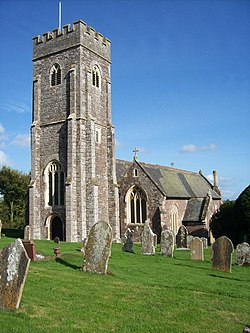Shobrooke
| Shobrooke | |
| Devon | |
|---|---|
 St Swithun's Church, Shobrooke | |
| Location | |
| Grid reference: | SS867013 |
| Location: | 50°48’1"N, 3°36’22"W |
| Data | |
| Population: | 537 (2011) |
| Post town: | Crediton |
| Postcode: | EX17 |
| Dialling code: | 01363 |
| Local Government | |
| Council: | Mid Devon |
Shobrooke is a village in Devon, about a mile and a half north-east of Crediton. It is located close to Shobrooke Park.
The river Shobrooke Lake flows through the village. It had a population of 537 according to the 2011 census.
Parish church
St Swithun's Church is the oldest structure in the village, the church is of Anglo Saxon origins and was rebuilt in the 15th Century, and restored further around 1840 and in 1879. The building is Grade II listed.[1]
History
Shobrooke has also been known as "Shobrook", the 1809 Ordnance Survey map refers the Parish and the village as Shobrook. Furthermore, in 1583 marriage records the village is once again referred to as Shobrook,[2] it is not known if this was an error or the name of the village has evolved over time.
In the 1870s, Shobrooke is described as:
A parish, with a village, in Crediton district, Devon; 2 miles NE of Crediton r. station. It has a post-office under Crediton, North Devon. Acres, 3835. Real property, £6,004. Pop. in 1851, 812; in 1861, 630. Houses, 133.[3]
About the village
The Red Lion Inn is the last remaining pub in Shobrooke, the pub dates back to the 1580s making it one of the oldest structures in the village.[4] The name of the Red Lion Inn has changed over time, in 1850 the pub was known as 'The Lion'.[5]
The Shobrooke 1914–1918 War Memorial holds the names of 25 men who lost their lives in the First World War, a list which includes the names of three brothers from the Hornwell family, all of whom died within 15 months of one another.[6]
A number of historic estates exist in the Parish of Shobrooke. The most well known is that of Shobrooke Park also known as Little Fulford or Shobrooke House.[7] According to local legend the name of Shobrooke Park was changed from Fulford Park due to a funeral director going to a different Fulford Park near Tedburn St Mary.[8]
Little Fulford served as a school during the Second World War for St Peter's Court, a preparatory school evacuated from Broadstairs, Kent, but burnt down in on 23 January 1945 with the loss of two pupils.[9] The site was empty until 1975 when the present owner Sir John Richard Shelley, 11th Baronet built a new house on the land.[7]
There are currently 48 buildings and structures within the parish that are listed buildings.[10]
Outside links
| ("Wikimedia Commons" has material about Shobrooke) |
References
- ↑ Church of St Swithin, Shobrooke - British Listed Buildings
- ↑ Richardson, Douglas (2011). Plantagenet Ancestry: A Study In Colonial And Mediæval Families (2nd ed.). Genealogical Pub Co. p. 211. ISBN 1449966314.
- ↑ Wilson, John Marius: Imperial Gazetteer of England and Wales (A. Fullerton & Co., 1870) – Shobrooke on Vision of Britain
- ↑ The Red Lion Inn at Shobrooke
- ↑ Brine, M E: Shobrooke in White's Directory of 1850 - Devon Heritage
- ↑ Brine, M.E. "SHOBROOKE 1914 – 1918 WAR MEMORIAL". http://www.devonheritage.org/Places/Shobrooke/ShobrookeWarMemorial1914-1918.htm. Retrieved 24 March 2015.
- ↑ 7.0 7.1 National Heritage List 1000702: Shobrooke Park
- ↑ "Doomesday Reloaded". http://www.bbc.co.uk/history/domesday/dblock/GB-284000-99000/page/3. Retrieved 18 March 2015.
- ↑ Browne, M.E.. "Fire at Shobrooke House – January 1945". http://www.devonheritage.org/Places/Shobrooke/FireatShobrookePark.htm. Retrieved 5 March 2015.
- ↑ Listed Buildings in Shobrooke: British Listed Buildings
